Measurement and Evaluation of Metal-to-Metal Seals Sealability by Ultrasonic Phased Array
Abstract
1. Introduction
2. Theoretical Part
2.1. Sealing Principle of Premium Connection
2.2. Propagation of Ultrasonic Phased Array Signals at the Sealing Interface
3. Experimental Part
3.1. Experimental Equipment and Materials
3.2. The Selection of Activation Aperture and the Reflection Peak Extraction of Sealing Interface
3.3. Calibration Experiment
4. Results and Discussion
4.1. Calculation of Contact Stress
4.2. Ultrasonic Phased Array Signal of Cone-Cone Contact Surface during Loading
4.3. Contact Stress Measurement of Specimens at Different Angles
4.4. Evaluation of Sealability
5. Conclusions
- The measurement effects of deflection and focusing-deflection modes on the sealing surface with different lengths and angles are investigated. The findings demonstrate that the sealing surface’s reflected wave peak exhibits a convex distribution and that the echo energy received declines with the rise of the sealing surface angle. In the focusing-deflection mode, the number of acoustic beams with a high peak of the sealing interface is increased, sidelobe clutter is reduced, the interference of other interface-reflected waves is reduced, and the energy of the acoustic beam is concentrated in contrast, so the measurement effect is better. The reflected wave peak of the sealing surface is extracted using the time compensation method.
- The reflected wave peak distribution on the sealing surface under different axial loads was investigated experimentally. The results show that with the increase of the axial load, the reflected wave peak of samples at different angles all show a decreasing trend, but not uniform. The reflection of the large end of the contact declines most sharply. The axial displacement of the contact interface can be seen from the distribution of the reflected wave peak and the reflection coefficient change trend.
- The reflection coefficient of the sealing interface is yielded using the ultrasonic phased array measurement method, and the contact stress distribution of the sealing interface is determined in accordance with the calibration results of the contact stress-reflection coefficient. The finite element 2D model of the contact specimen is built to calculate the contact stress of the cone surface, and the two are compared. As indicated by the results, the contact stress distribution trends obtained using the two methods are consistent, and the ultrasonic phased array measurement method is capable of sensitively calculating the effect of the reasonable angle machining error of the sealing surface on the contact distribution.
- The sealing index can be adopted to quantify sealability. The sealing index increases with the increase of axial load, which means that the sealing requirements of higher gas pressure can be met. Compared with the calculated results of finite elements, the measurement error of the ultrasonic phased array is less than 15% in the allowable error range. Moreover, the measurement error will be reduced with the decrease in the angle of the sealing surface.
- Lastly, the contact stress distribution nephogram of the sealing interface under low and high loads is formed to visualise the contact stress distribution of the sealing surface, which is promising in engineering applications.
Author Contributions
Funding
Data Availability Statement
Conflicts of Interest
References
- Cui, F.; Li, W.J.; Wang, G.Z.; Gu, Z.L.; Wang, Z.S. Design and study of gas-tight premium threads for tubing and casing. J. Pet. Sci. Eng. 2015, 133, 208–217. [Google Scholar] [CrossRef]
- Egbert, V.R.; Jeroen, V.W.; Dennis, V.H.; Roel, R.; Vanderschueren, M.; Thibaux, P. On the suitability of premium OCTG tubing connections for CCS CO2 injection wells–a full scale physical evaluation. Int. J. Greenh. Gas Control 2023, 123, 103834. [Google Scholar] [CrossRef]
- Li, Y.F.; Cao, Y.P.; Dou, Y.H.; Yu, Y.; Zhang, J.T.; Zhang, L. Simulation of Sealing Ability for Premium Connection Based on ISO 13679 CAL IV Tests. Procedia Struct. Integr. 2019, 22, 43–50. [Google Scholar] [CrossRef]
- Chen, W.; Di, Q.F.; Zhang, H.; Chen, F.; Wang, W. The sealing mechanism of tubing and casing premium threaded connections under complex loads. J. Pet. Sci. Eng. 2018, 171, 724–730. [Google Scholar] [CrossRef]
- Degeare, J. Chapter 18—Repair of Casing Failures and Leaks. In The Guide to Oilwell Fishing Operations, 2nd ed.; Elsevier: New York, NY, USA, 2015; pp. 133–140. [Google Scholar] [CrossRef]
- Harshkumar, P.; Saeed, S.; Ramadan, A.; Catalin, T. Review of elastomer seal assemblies in oil & gas wells: Performance evaluation, failure mechanisms, and gaps in industry standards. J. Pet. Sci. Eng. 2019, 179, 1046–1062. [Google Scholar] [CrossRef]
- Zhu, S.D.; Wei, J.F.; Cai, R.; Bai, Z.Q.; Zhou, G.S. Corrosion failure analysis of high strength grade super 13Cr-110 tubing string. Eng. Fail. Anal. 2011, 18, 2222–2231. [Google Scholar] [CrossRef]
- Cirimello, P.G.; Otegui, J.L.; Guillermo, C.; Walter, M. Failure and integrity analysis of casings used for oil well drilling. Eng. Fail. Anal. 2017, 75, 1–14. [Google Scholar] [CrossRef]
- Guo, X.Q.; Liu, J.; Dai, L.M.; Liu, Q.Y.; Fang, D.K.; Wei, A.C.; Wang, J.X. Friction-wear failure mechanism of tubing strings used in high-pressure, high-temperature and high-yield gas wells. Wear 2021, 468–469, 203576. [Google Scholar] [CrossRef]
- Xu, J.W.; Mou, Y.S.; Xue, C.G.; Ding, L.L.; Wang, R.Y.; Ma, D.D. The study on erosion of buckling tubing string in HTHP ultra-deep wells considering fluid–solid coupling. Energy Rep. 2021, 7, 3011–3022. [Google Scholar] [CrossRef]
- Chen, S.S.; Wang, H.X.; Liu, Y.X.; Lan, W.; Lv, X.X.; Sun, B.Y.; Yuan, D.X. Root cause analysis of tubing and casing failures in low-temperature carbon dioxide injection well. Eng. Fail. Anal. 2019, 104, 873–886. [Google Scholar] [CrossRef]
- Jonathan, B. Chapter 8 Material Selection. In Developments in Petroleum Science; Elsevier: New York, NY, USA, 2009; Volume 56, pp. 433–472. [Google Scholar] [CrossRef]
- Hamilton, K.; Wagg, B.; Tim, R. Using Ultrasonic Techniques to Accurately Examine Seal Surface Contact Stress in Premium Connections. In Proceedings of the SPE Annual Technical Conference and Exhibition, Anaheim, CA, USA, 11–14 November 2007. [Google Scholar] [CrossRef]
- Xu, H.L.; Yang, B.; Zhang, Z.; Shi, T.H. Special considerations to calculate joint strength of premium connections. J. Pet. Sci. Eng. 2019, 182, 106295. [Google Scholar] [CrossRef]
- Chen, F.; Di, Q.F.; Li, N.; Wang, C.S.; Wang, W.C.; Wang, M.J. Determination of operating load limits for rotary shouldered connections with three-dimensional finite element analysis. J. Pet. Sci. Eng. 2015, 133, 622–632. [Google Scholar] [CrossRef]
- ISO 13679; Petroleum and Natural Gas Industries—Procedures for Testing Casing and Tubing Connections. ISO: Geneva, Switzerland, 2019.
- Muth, R.B.; Bartrud, T.F. Leak Detection—“A Necessity In Today’s Industry”. J. Can. Pet. Technol. 1983, 22. [Google Scholar] [CrossRef]
- Slack, M.W.; Salkin, H.; Langer, F.H. Technique to Assess Directly Make-Up Contact Stress Inside Tubular Connections. In Proceedings of the IADC/SPE Drilling Conference, Houston, TX, USA, 27 February–2 March 1990. [Google Scholar] [CrossRef]
- Dennis, E.; Francesc, P.R.; Egbert, J.R.; John, V.V. On the Sealability of Metal-to-Metal Seals with Application to Premium Casing and Tubing Connections. SPE Drill. Complet. 2019, 34, 382–396. [Google Scholar] [CrossRef]
- Pau, M.; Aymerich, F.; Ginesu, F. Distribution of contact pressure in wheel–rail contact area. Wear 2002, 253, 265–274. [Google Scholar] [CrossRef]
- Tattersall, H.G. The ultrasonic pulse-echo technique as applied to adhesion testing. J. Phys. D Appl. Phys. 1973, 6, 819–823. [Google Scholar] [CrossRef]
- Dwyer-joyce, R.S.; Drinkwater, B.W.; Quinn, A.M. The Use of Ultrasound in the Investigation of Rough Surface Interfaces. J. Tribol. 2000, 123, 8–16. [Google Scholar] [CrossRef]
- Gonzalez-valadez, M.; Baltazar, A.; Dwyer-joyce, R.S. Study of interfacial stiffness ratio of a rough surface in contact using a spring model. Wear 2010, 268, 373–379. [Google Scholar] [CrossRef]
- Mulvihill, D.M.; Brunskill, H.; Kartal, M.E.; Dwyer-Joyce, R.S.; Nowell, D. A Comparison of Contact Stiffness Measurements Obtained by the Digital Image Correlation and Ultrasound Techniques. Exp. Mech. 2013, 53, 1245–1263. [Google Scholar] [CrossRef]
- Jamil, A.; Kambiz, F. Elastic–plastic contact model for rough surfaces based on plastic asperity concept. Int. J. Non-linear Mech. 2005, 40, 495–506. [Google Scholar] [CrossRef]
- Xiao, H.F.; Sun, Y.Y. An improved virtual material based acoustic model for contact stiffness measurement of rough interface using ultrasound technique. Int. J. Solids Struct. 2018, 155, 240–247. [Google Scholar] [CrossRef]
- Qi, T.Z.; Lin, L.; Zhang, S.N.; Ma, Z.Y. Identification interface stiffness of coating/substrate structure based on ultrasonic pressure reflection coefficient amplitude spectrum. Appl. Acoust. 2022, 201, 109094. [Google Scholar] [CrossRef]
- Du, F.; Li, B.T.; Zhang, J.; Zhu, Q.M.; Hong, J. Ultrasonic measurement of contact stiffness and pressure distribution on spindle–holder taper interfaces. Int. J. Mach. Tools Manuf. 2015, 97, 18–28. [Google Scholar] [CrossRef]
- Wang, S.; Yao, X.; Yang, H.; Huang, S. Measurement and evaluation on contact stress at the rubber contact interface. Measurement 2019, 146, 856–867. [Google Scholar] [CrossRef]
- Xu, N.; Zhou, Z.G. Numerical simulation and experiment for inspection of corner-shaped components using ultrasonic phased array. NDT E Int. 2014, 63, 28–34. [Google Scholar] [CrossRef]
- Johannes, R.; Chen, C.; Reza, V.; Anoush, P. Combining digital image correlation and phased-array ultrasonics for non-destructive testing of translaminar fracture in composite laminates. Compos. Part A Appl. Sci. Manuf. 2022, 161, 107060. [Google Scholar] [CrossRef]
- Zhang, H.Y.; Peng, L.; Zhang, H.; Zhang, T.; Zhu, Q. Phased array ultrasonic inspection and automated identification of wrinkles in laminated composites. Compos. Struct. 2022, 300, 116170. [Google Scholar] [CrossRef]
- Ma, M.; Cao, H.; Jiang, M.; Sun, L.; Zhang, L.; Zhang, F.; Sui, Q.; Tian, A.; Liang, J.; Jia, L. High Precision Detection Method for Delamination Defects in Carbon Fiber Composite Laminates Based on Ultrasonic Technique and Signal Correlation Algorithm. Materials 2020, 13, 3840. [Google Scholar] [CrossRef]
- Cao, H.Y.; Jiang, M.S.; Jia, L.; Ma, M.Y.; Sun, L.; Zhang, L.; Tian, A.Q.; Liang, J.Y. An ultrasonic signal processing method to improve defect depth estimation in composites based on empirical mode decomposition. Meas. Sci. Technol. 2021, 32, 135112. [Google Scholar] [CrossRef]
- Zhou, L.; Henry, B.; Roger, L. Experimental investigation on ball plate contact using ultrasonic reflectometry: From static to dynamic. Ultrasonics 2022, 124, 106733. [Google Scholar] [CrossRef]
- Han, T.; Fan, J.C. Assessment of stress distribution in premium connections with ultrasonic phased array and metal magnetic memory. J. Physic Conf. Ser. 2021, 2045, 012012. [Google Scholar] [CrossRef]
- Fayazbakhsh, K.; Honarvar, F.; Amini, H.; Varvani-Farahani, A. High frequency phased array ultrasonic testing of thermoplastic tensile specimens manufactured by fused filament fabrication with embedded defects. Addit. Manuf. 2021, 47, 102335. [Google Scholar] [CrossRef]
- Filho, J.C.P.; Maia, V.P.; Passos, E.K.D.; Gonzaga, R.S.; Juliano, D.R. Probability of detection of discontinuities by ultrasonic phased array inspection of 9% Ni steel joints welded with alloy 625 as the filler metal. Ultrasonics 2022, 119, 106582. [Google Scholar] [CrossRef]
- Zhang, M.; Suo, S.; Jiang, Y.; Meng, G. Experimental Measurement Method for Contact Stress of Elastic Metal Sealing Ring Based on Pressure Sensitive Paper. Metals 2018, 8, 942. [Google Scholar] [CrossRef]
- Ye, F.; Chen, F.; Wang, W.V.; Zhang, R.L.; Zhou, X.; Qin, K.; Di, Q.F. Flow in Microchannels between Sealing Surfaces of Casing Connections: LBM Simulation. Geofluids 2023, 2023, 5293830. [Google Scholar] [CrossRef]
- Murtagian, G.R.; Fanelli, V.; Villasante, J.A.; Johnson, D.H.; Ernst, H.A. Sealability of Stationary Metal-to-Metal Seals. J. Tribol. 2004, 126, 591–596. [Google Scholar] [CrossRef]
- Yang, B.; Xu, H.L.; Xiang, S.L.; Zhang, Z.; Su, K.H.; Yang, Y. Effects of Make-Up Torque on the Sealability of Sphere-Type Premium Connection for Tubing and Casing Strings. Processes 2023, 11, 256. [Google Scholar] [CrossRef]
- Gonzalez-Valadez, M.; Dwyer-Joyce, R.S.; Lewis, R. Ultrasonic Reflection from Mixed Liquid-Solid Contacts and the Determination of Interface Stiffness. Tribol. Interface Eng. Ser. 2005, 48, 313–320. [Google Scholar] [CrossRef]
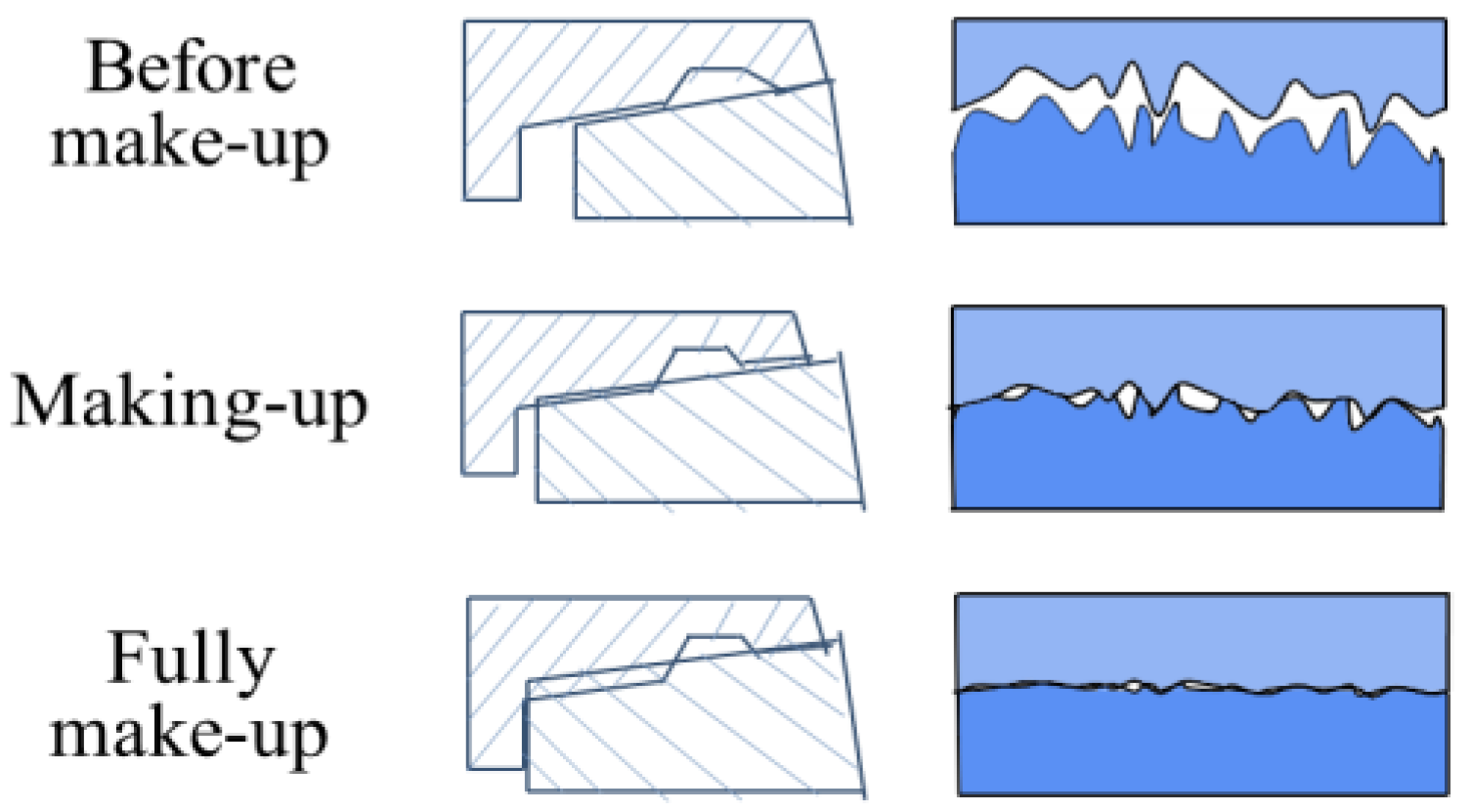
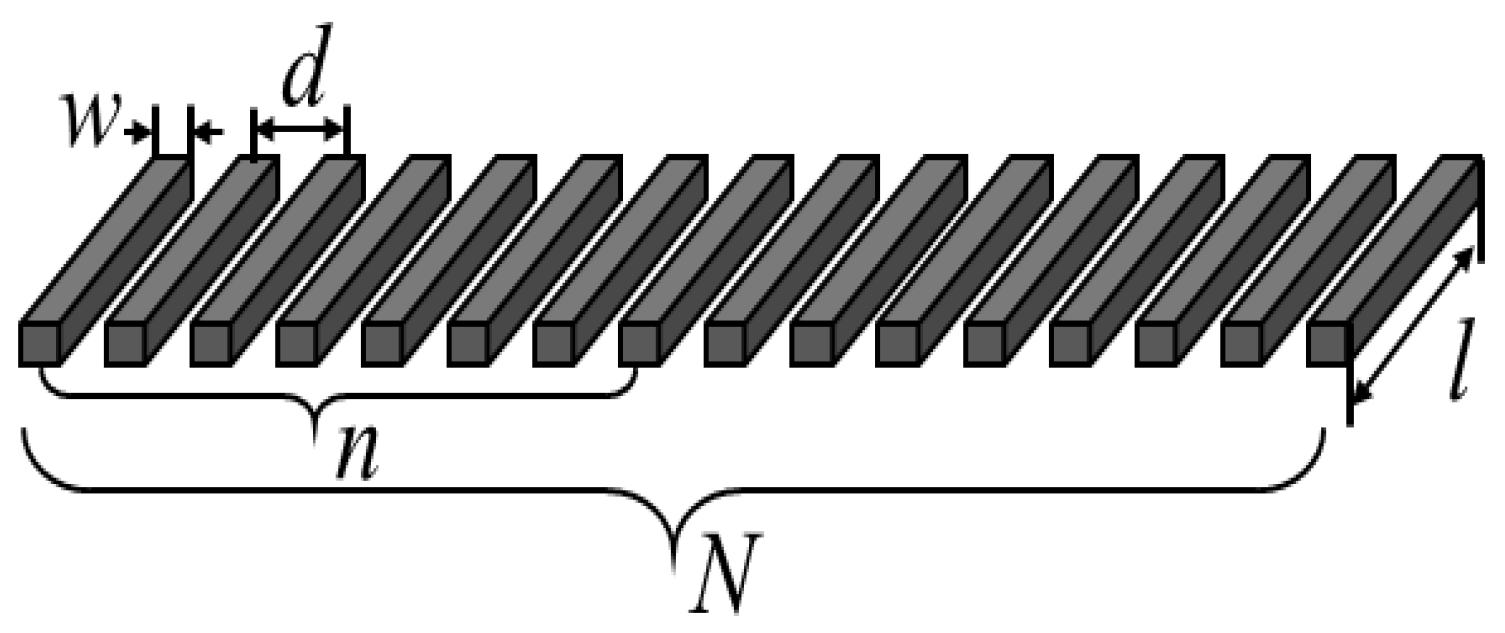


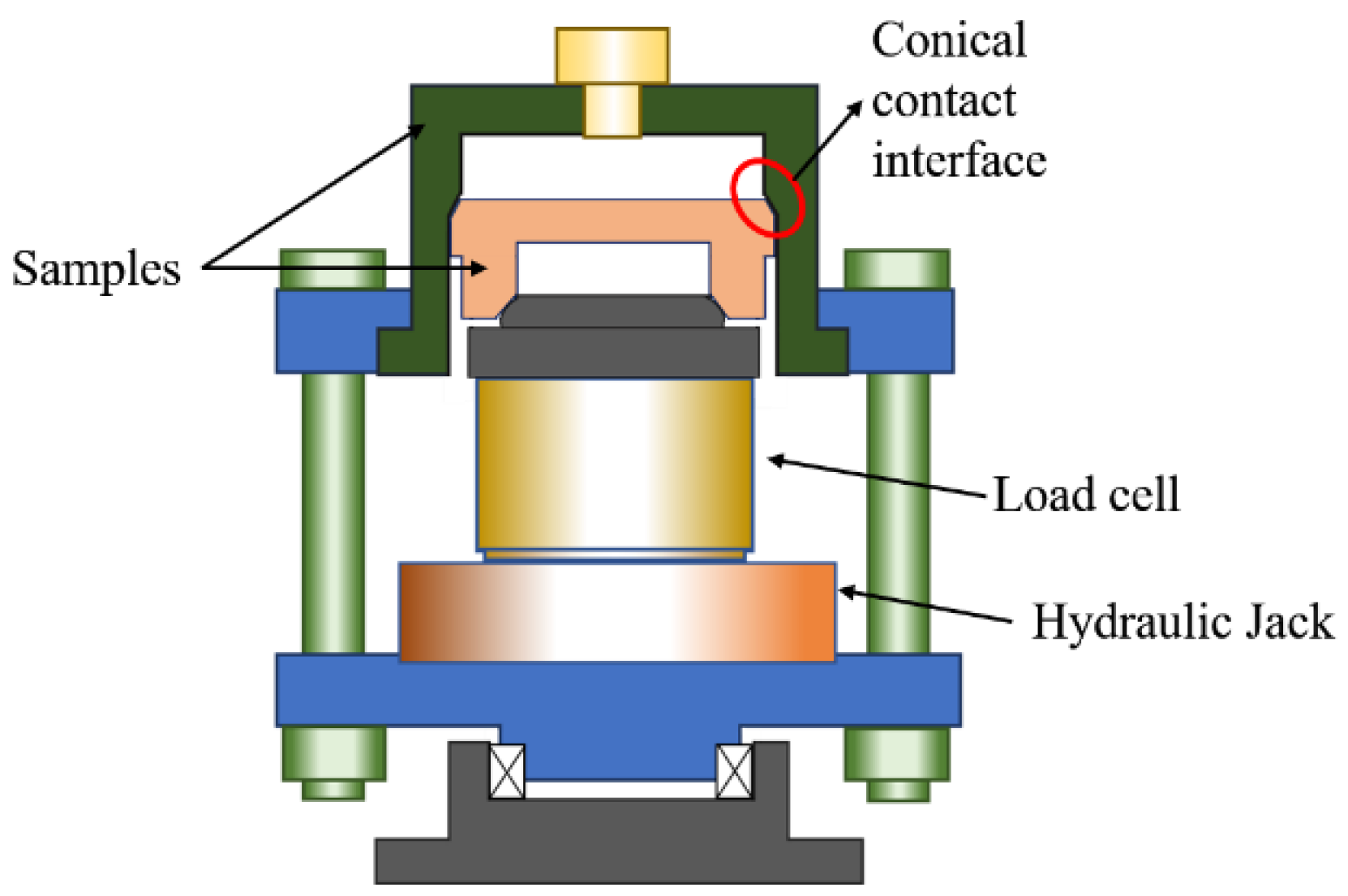
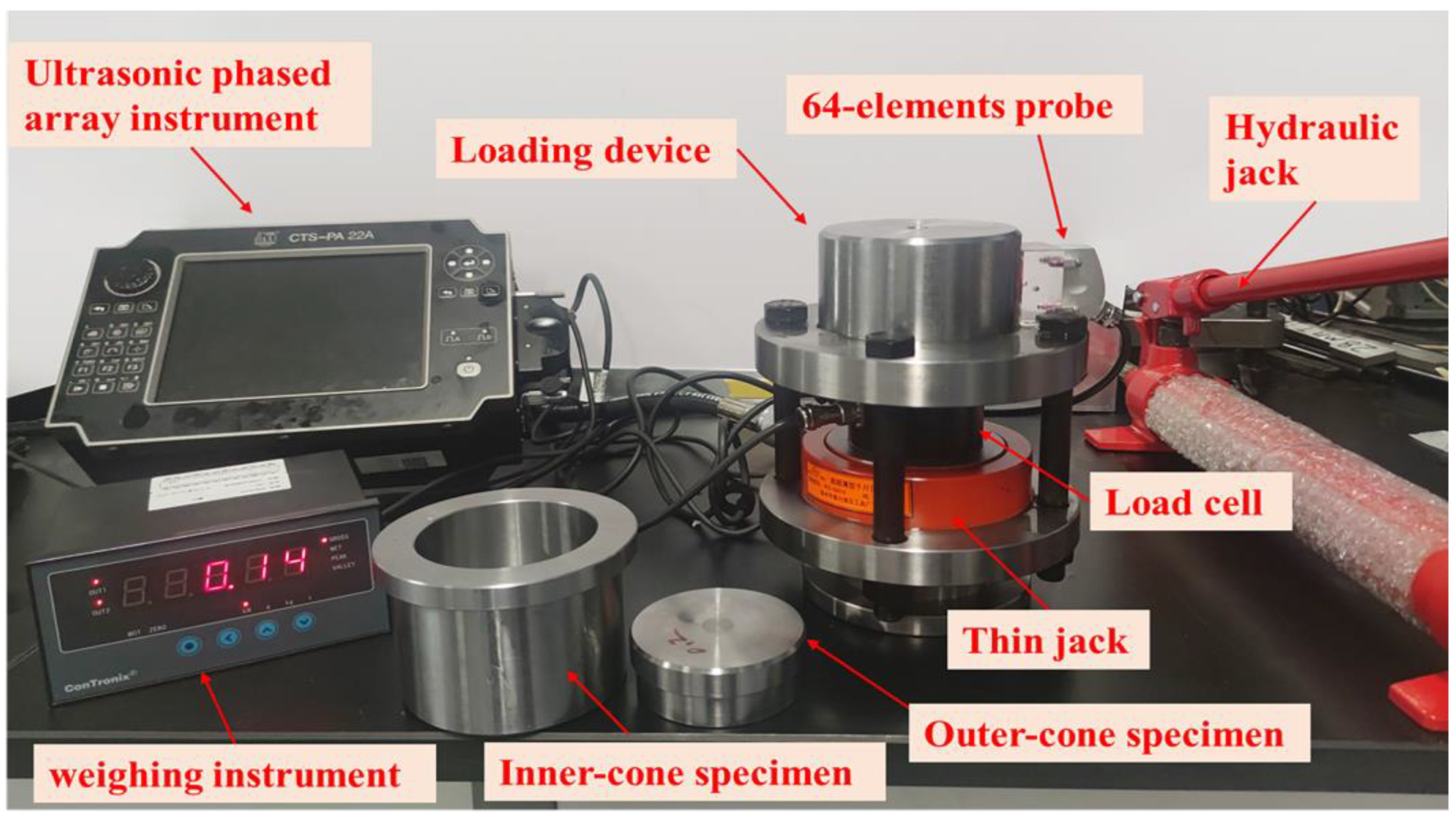


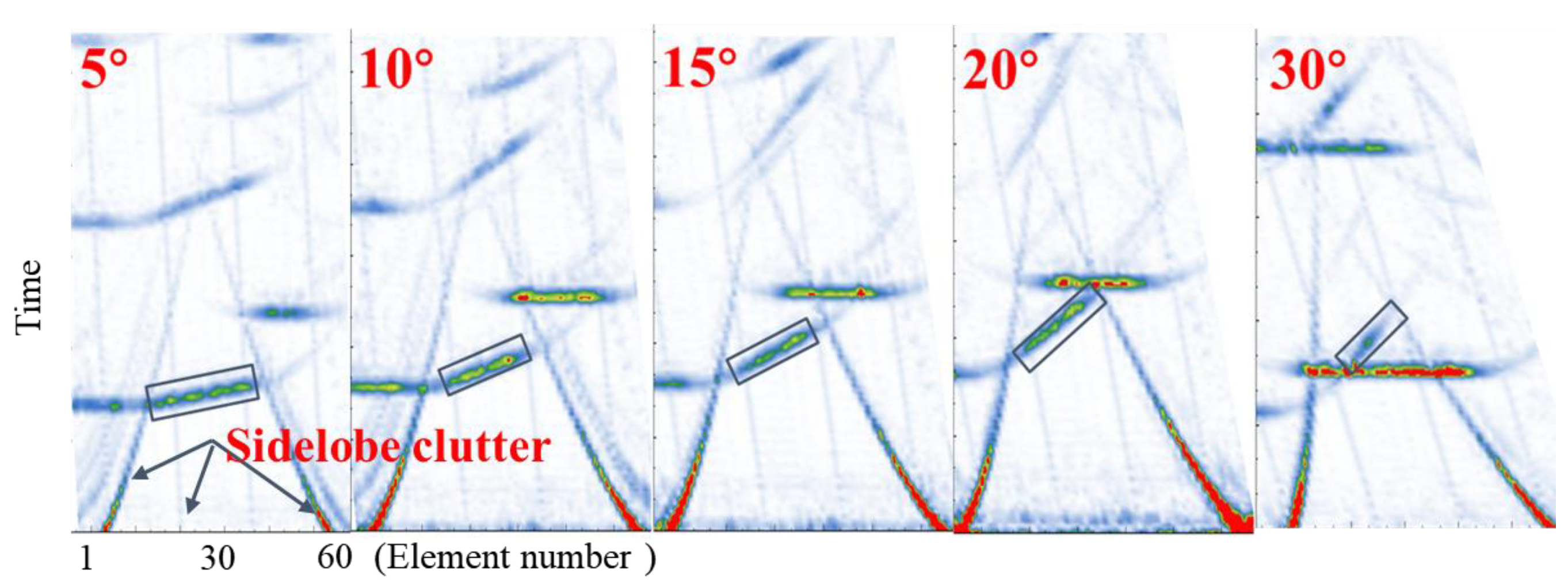
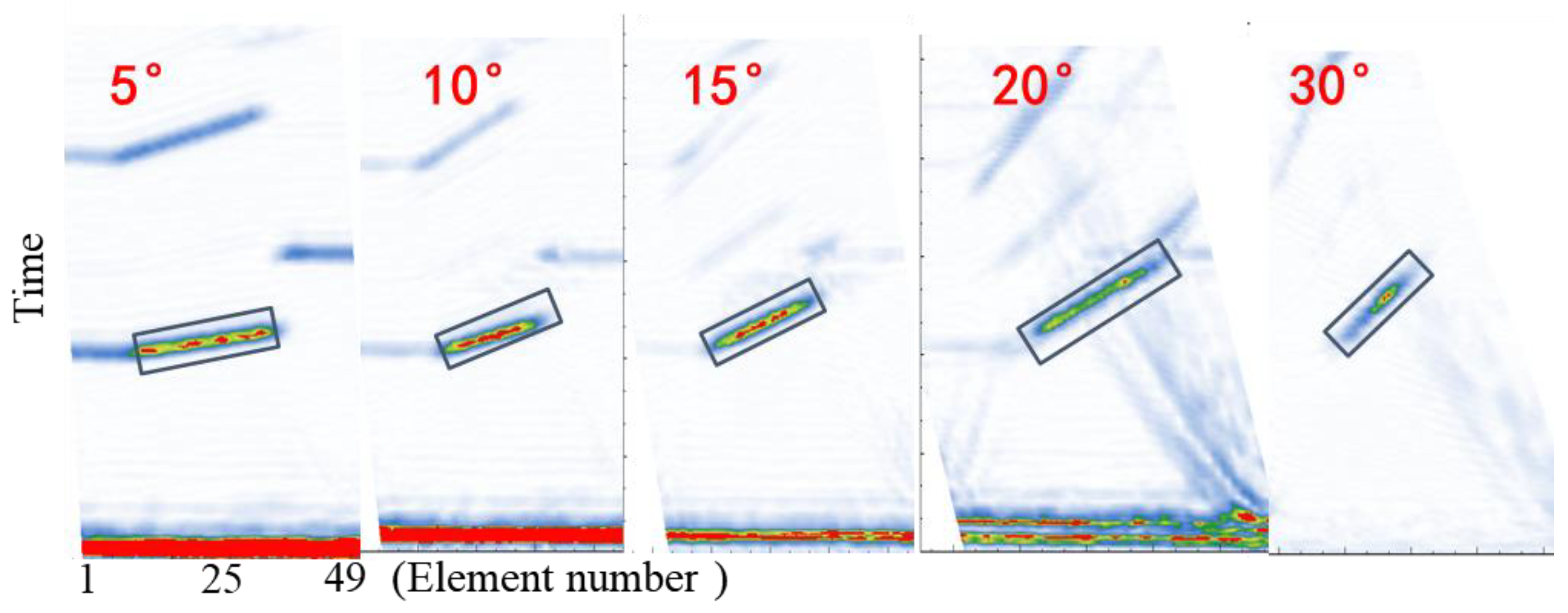
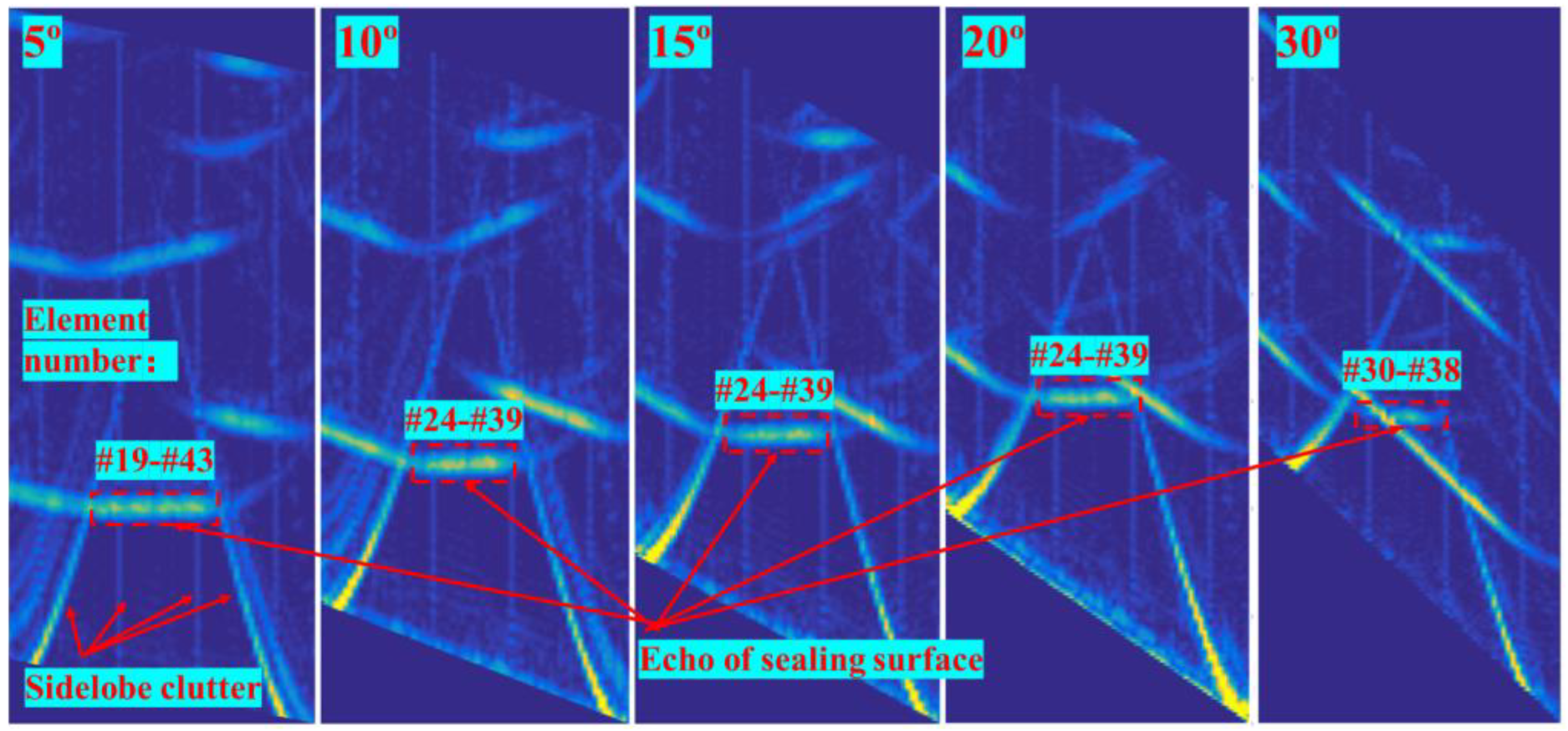

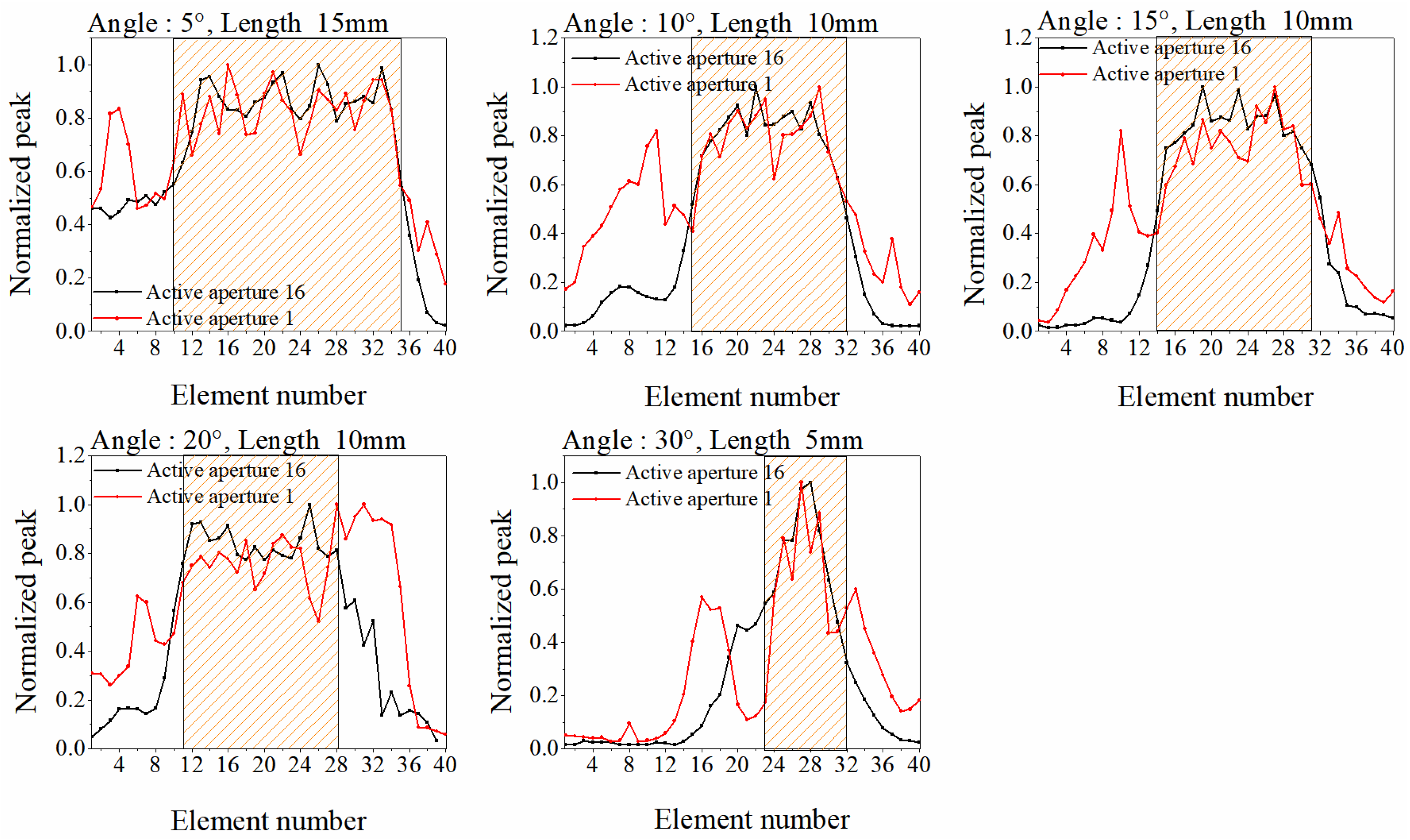
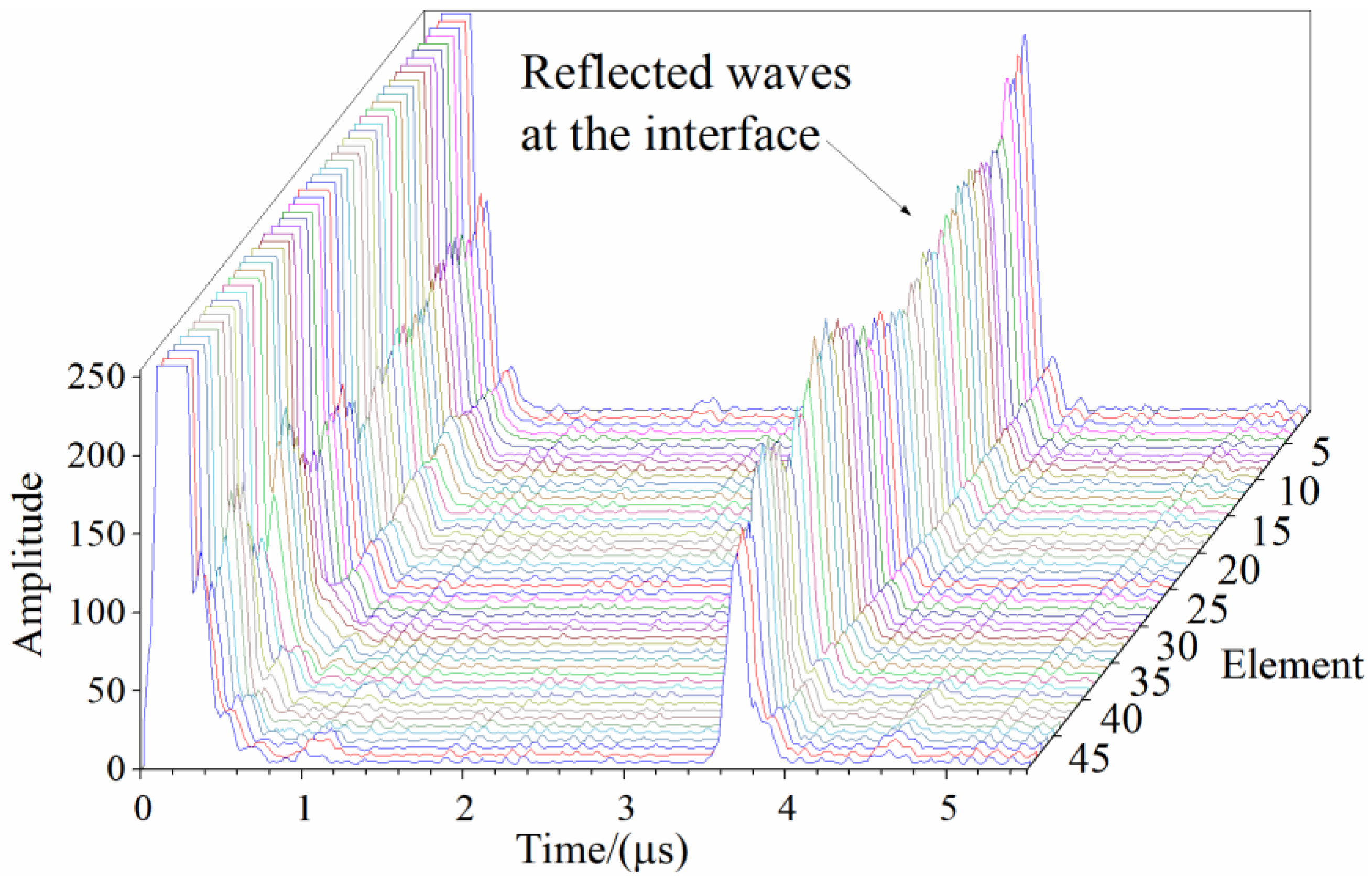
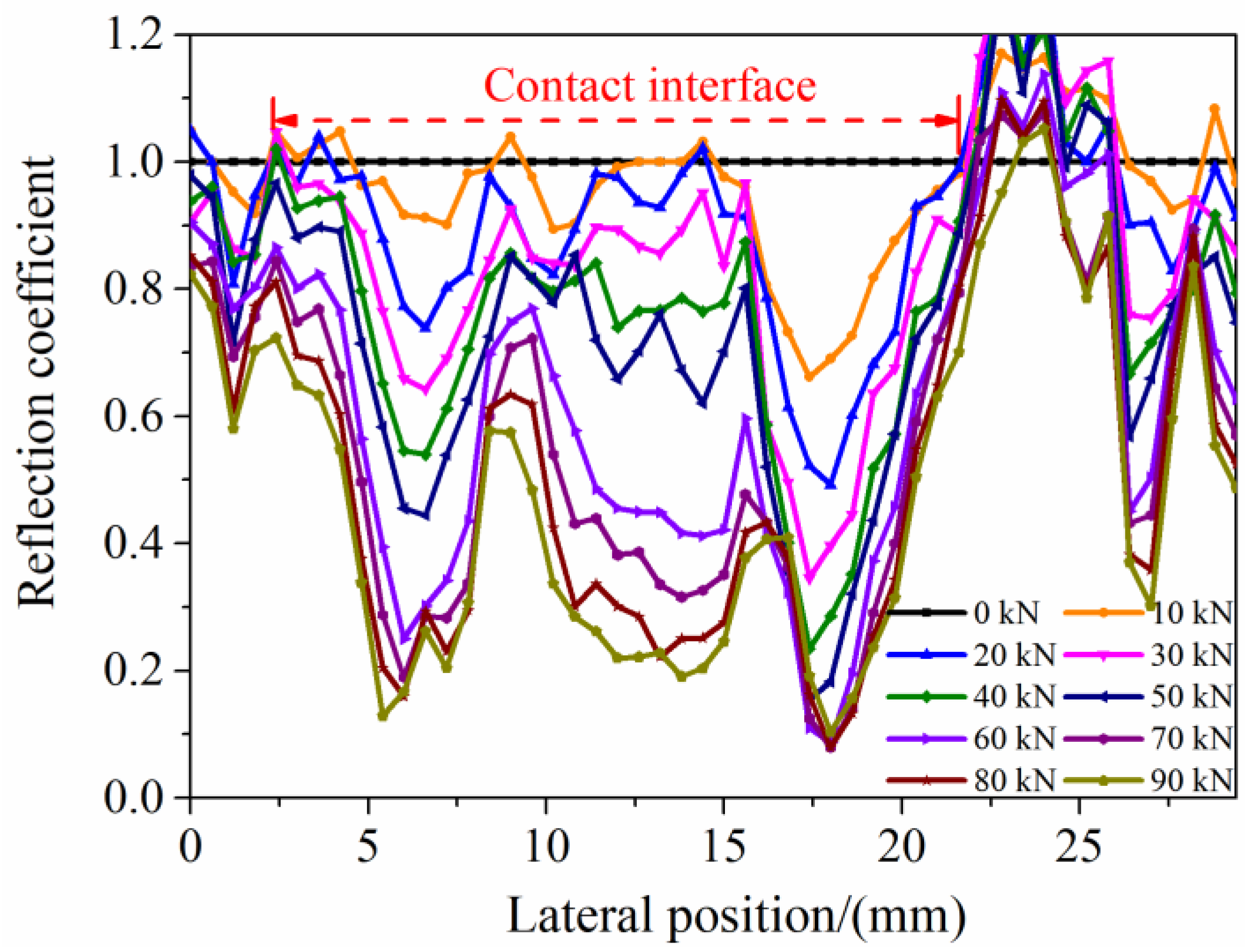
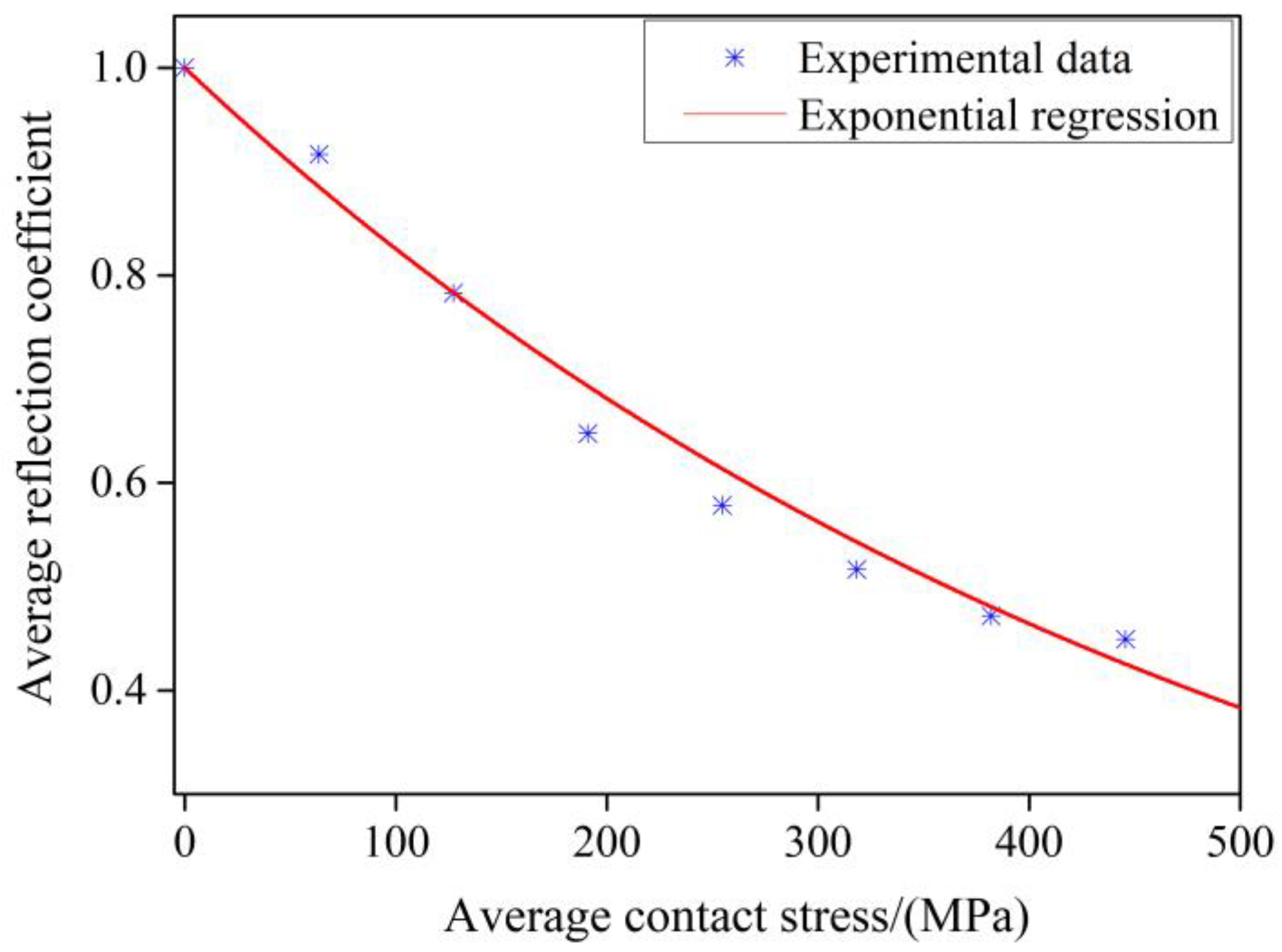
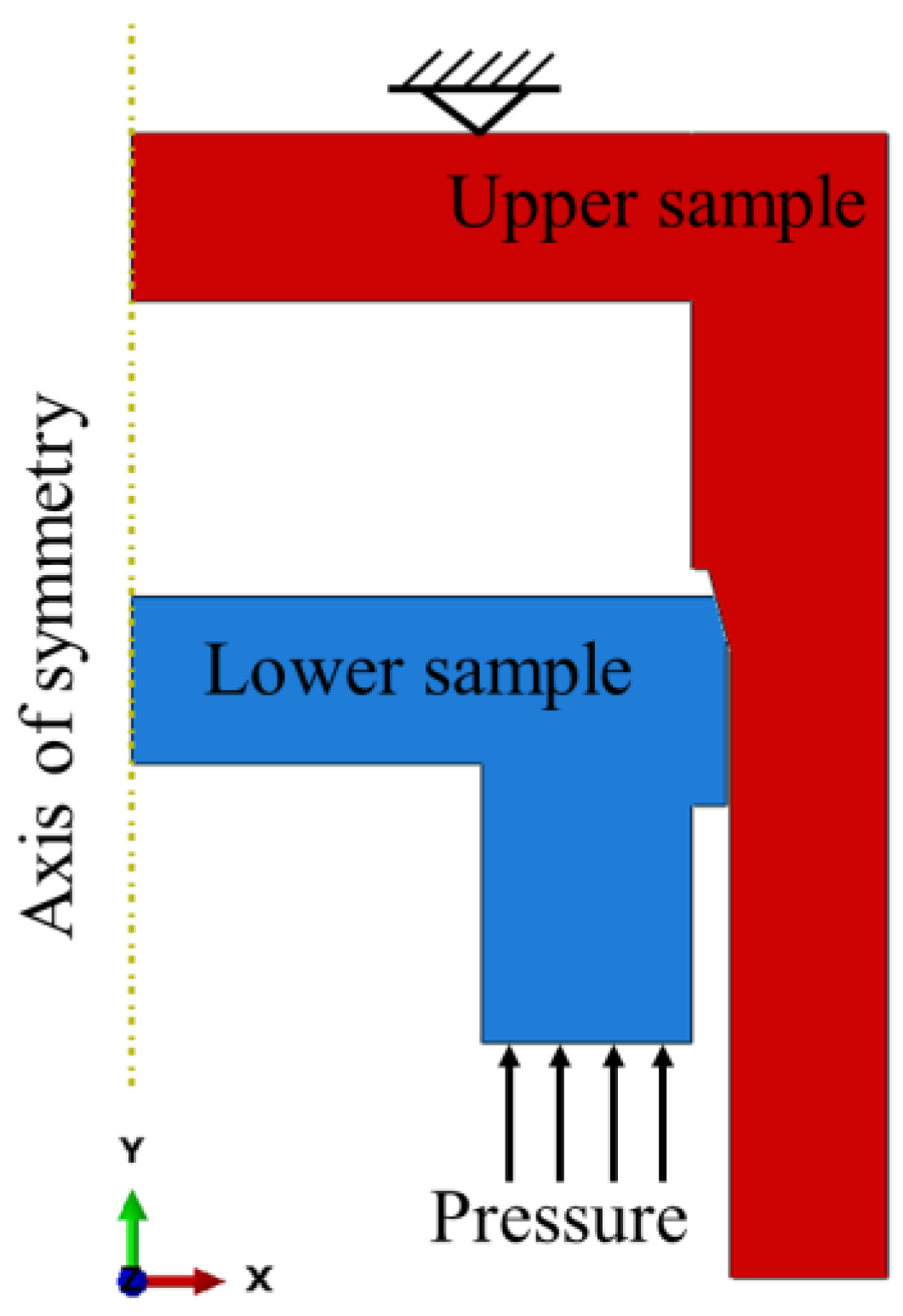

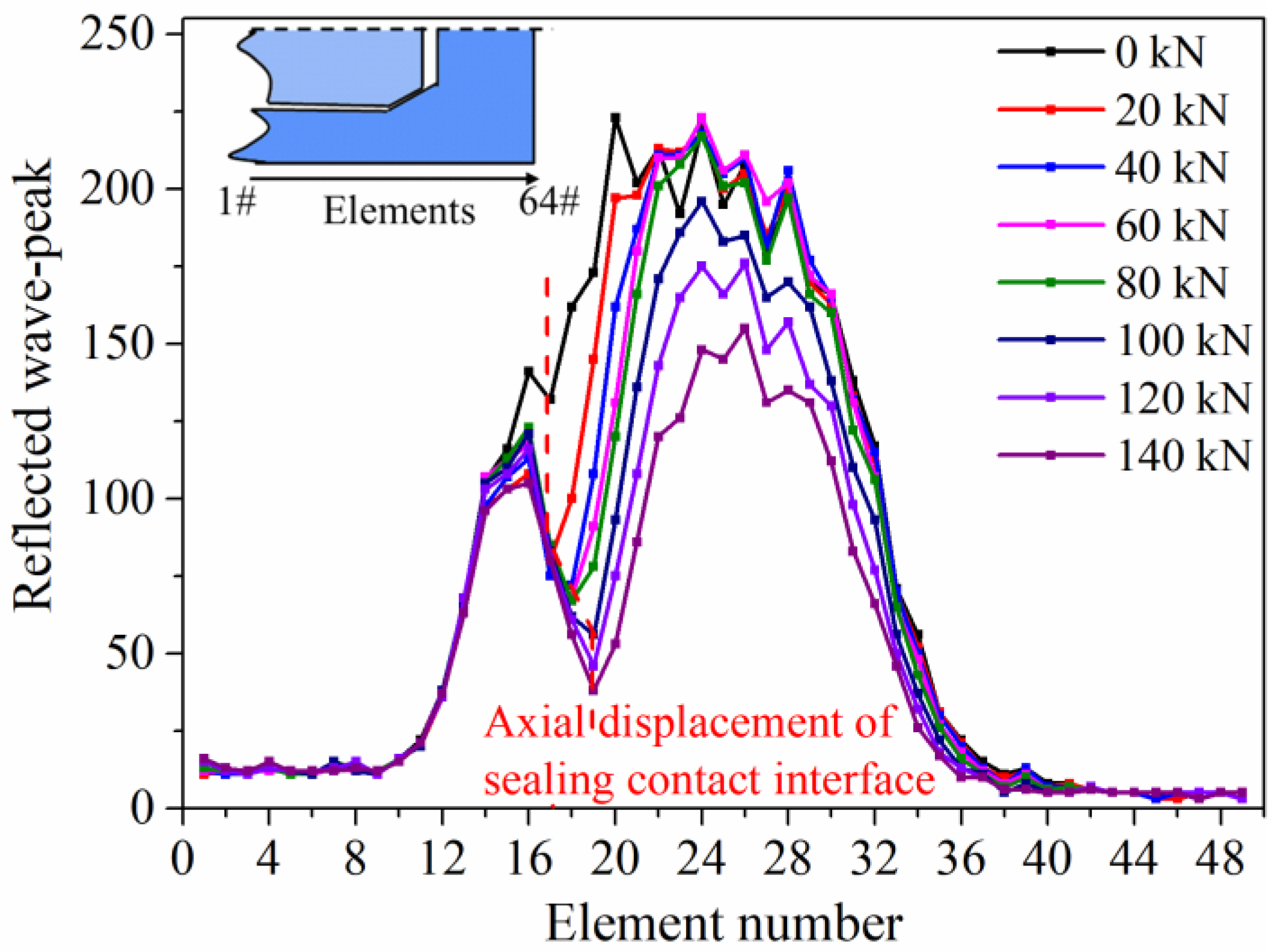
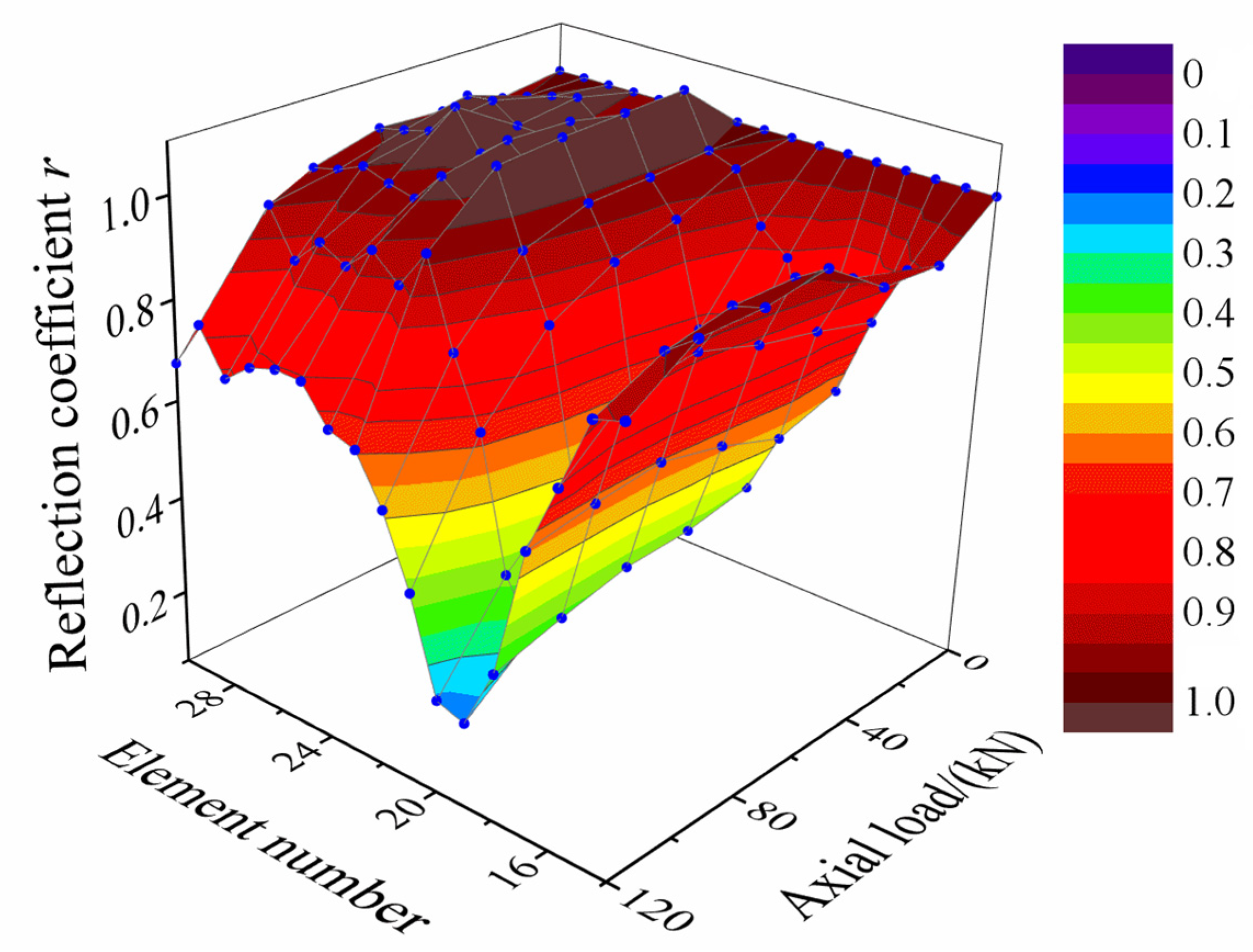
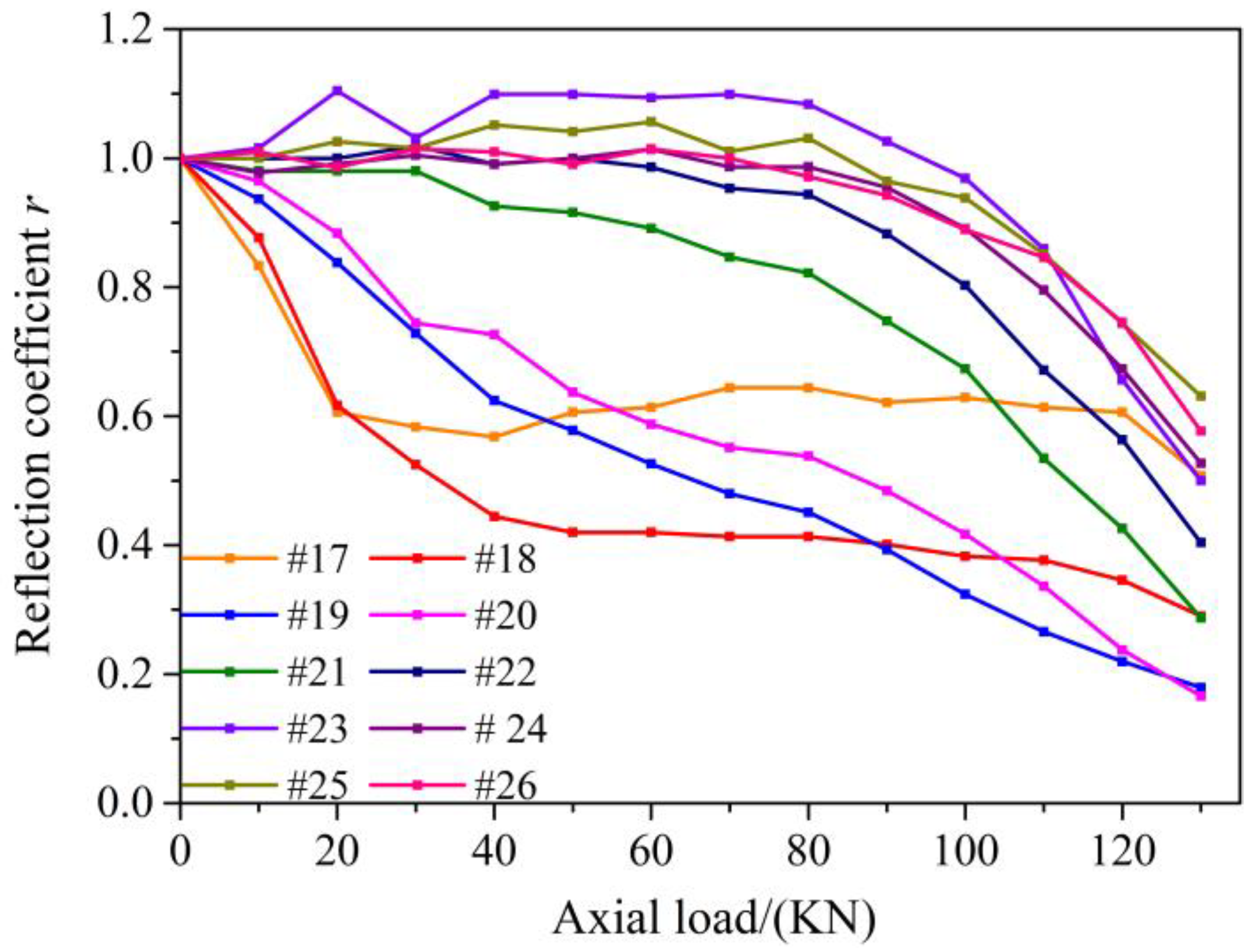


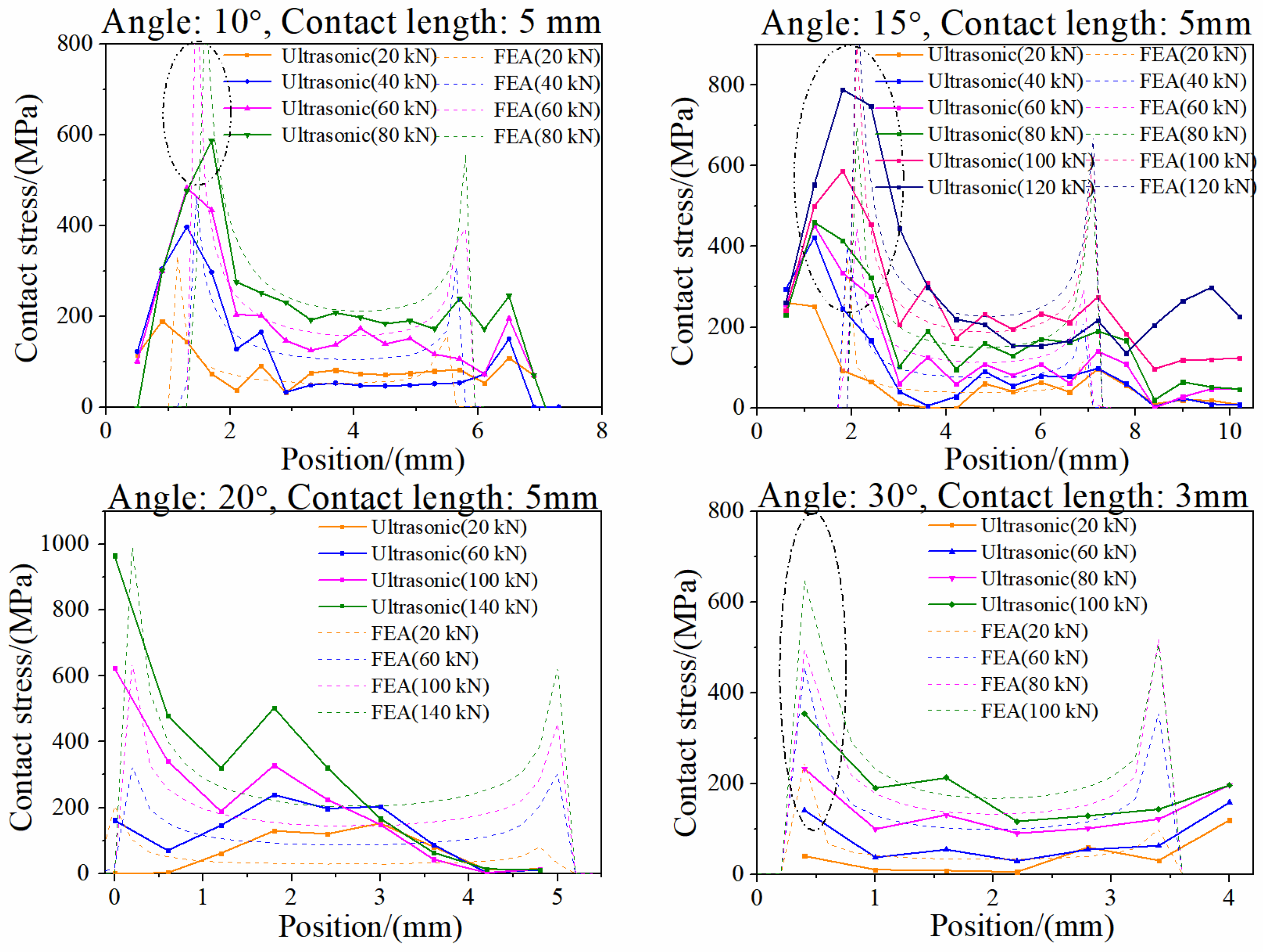
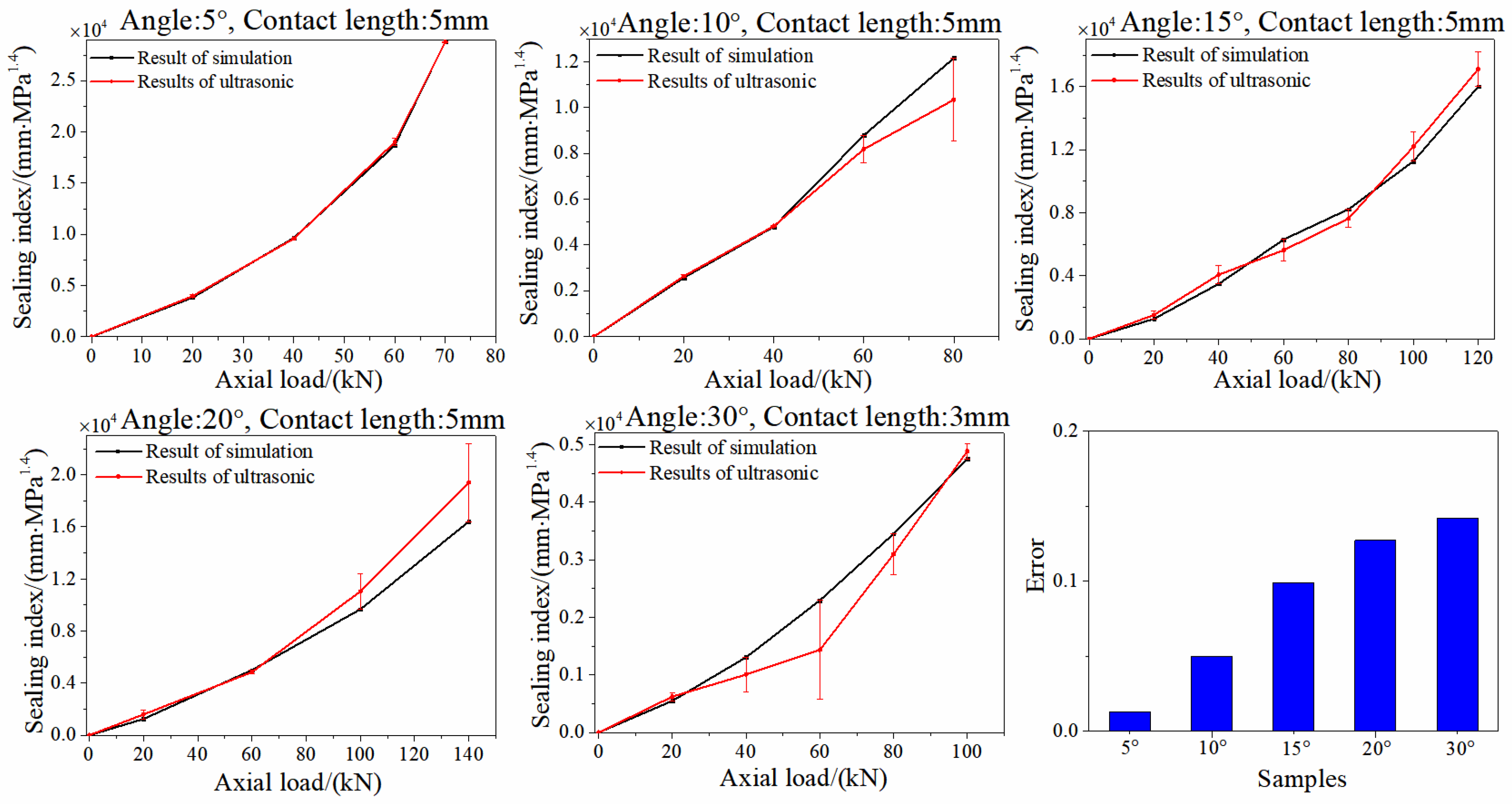
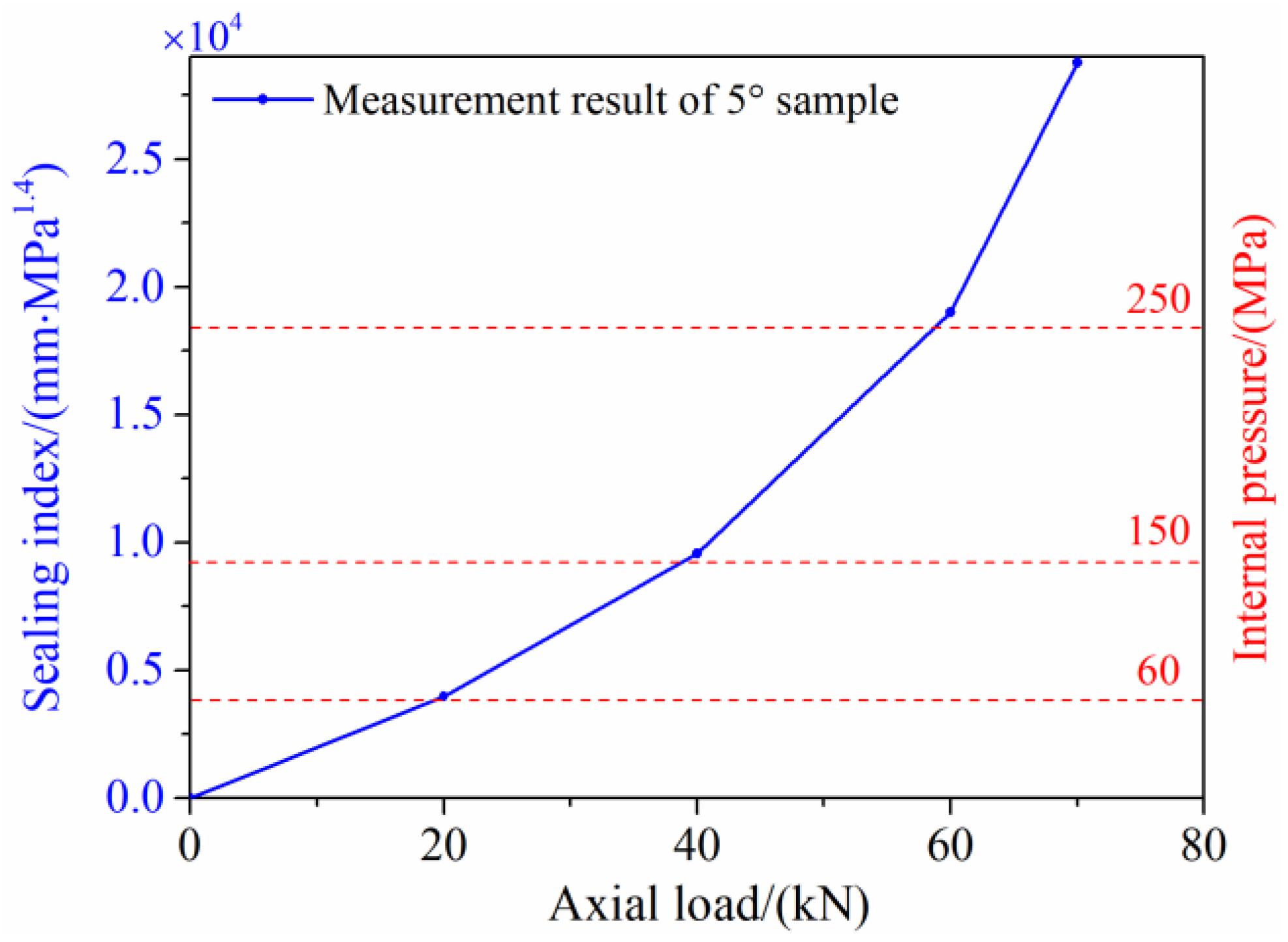
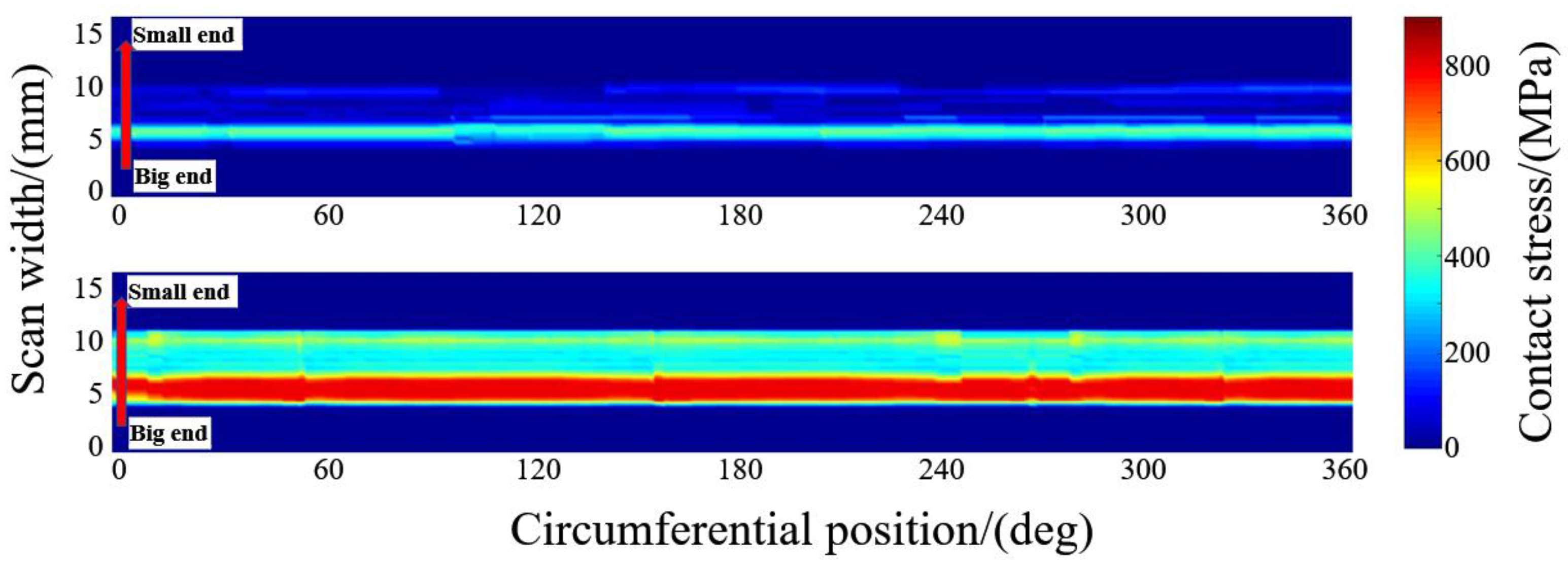
| Frequency (MHz) | Elements Number | Element Spacing (mm) | Element Width (mm) | Effective Aperture (mm) | Element Length (mm) |
|---|---|---|---|---|---|
| 5 | 64 | 0.6 | 0.5 | 38.4 | 10 |
| Samples | Actual Cone Angle/(°) | Length of Seal Surface/(mm) | Ra/(µm) | Equivalent Ra/(µm) | |
|---|---|---|---|---|---|
| 5° | Box | 5.15 | 15 | 0.99 | 1.49 |
| Pin | 4.99 | 5 | 1.12 | ||
| 10° | Box | 10.27 | 10 | 1.05 | 1.44 |
| Pin | 10.07 | 5 | 0.98 | ||
| 15° | Box | 15.27 | 10 | 1.13 | 1.59 |
| Pin | 15.17 | 5 | 1.12 | ||
| 20° | Box | 19.91 | 10 | 1.10 | 1.55 |
| Pin | 20.14 | 5 | 1.09 | ||
| 30° | Box | 30.05 | 5 | 1.11 | 1.46 |
| Pin | 29.86 | 3 | 0.95 | ||
Disclaimer/Publisher’s Note: The statements, opinions and data contained in all publications are solely those of the individual author(s) and contributor(s) and not of MDPI and/or the editor(s). MDPI and/or the editor(s) disclaim responsibility for any injury to people or property resulting from any ideas, methods, instructions or products referred to in the content. |
© 2023 by the authors. Licensee MDPI, Basel, Switzerland. This article is an open access article distributed under the terms and conditions of the Creative Commons Attribution (CC BY) license (https://creativecommons.org/licenses/by/4.0/).
Share and Cite
Han, T.; Fan, J. Measurement and Evaluation of Metal-to-Metal Seals Sealability by Ultrasonic Phased Array. Metals 2023, 13, 1032. https://doi.org/10.3390/met13061032
Han T, Fan J. Measurement and Evaluation of Metal-to-Metal Seals Sealability by Ultrasonic Phased Array. Metals. 2023; 13(6):1032. https://doi.org/10.3390/met13061032
Chicago/Turabian StyleHan, Ting, and Jianchun Fan. 2023. "Measurement and Evaluation of Metal-to-Metal Seals Sealability by Ultrasonic Phased Array" Metals 13, no. 6: 1032. https://doi.org/10.3390/met13061032
APA StyleHan, T., & Fan, J. (2023). Measurement and Evaluation of Metal-to-Metal Seals Sealability by Ultrasonic Phased Array. Metals, 13(6), 1032. https://doi.org/10.3390/met13061032





